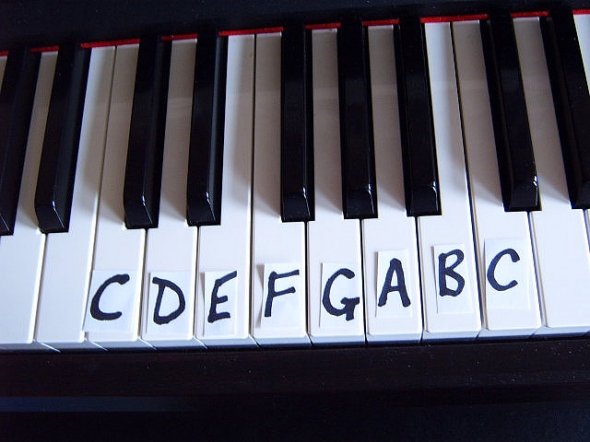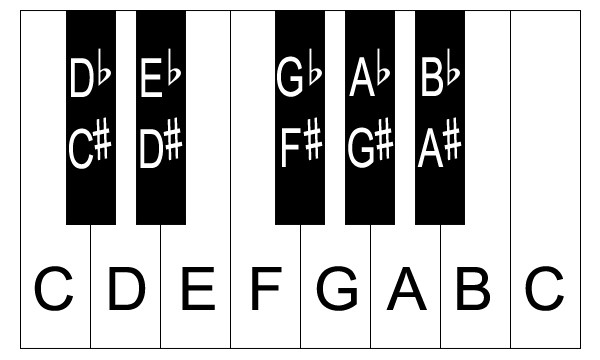Hello future pianists! As many of you have already figured out, learning how to play the piano is no simple task. My goal for you is to allow you to be independent musicians that require no outside help in playing piano music other than the aid of pieces of sheet music. For most of you, that last statement probably sounds immensely ambitious given that you don’t even know how to read a piece of sheet music at the moment. However, if you follow my blog, reading the music will start to become more natural, and I will guide you through your first songs as a pianist!
Before being able to understand how piano music works, you must first understand how the keys on a piano are organized. While at first a piano may look intimidating due to the large amount of keys that it has, it is much simpler than it looks. Every piano is organized into seven basic notes that represent the steps in pitch between adjacent keys on the piano. These notes are represented by letters of the alphabet from A to G, and they are the white keys on the piano (don’t worry about the black keys for now, I will get to them soon). All traditional pianos start and end on the same note, and the first key on the piano (the key to the far left) is given the letter A. The white key to the adjacent right of that is B, and to the right of that is C, and so on until G is reached. After G, the cycle starts over again and the next note is A. Notice that the pattern between the white keys and the black keys is always the same respective to the key’s given letter as you move down the piano. So far, you have learned that the white keys of a piano are organized like this:
Before being able to understand how piano music works, you must first understand how the keys on a piano are organized. While at first a piano may look intimidating due to the large amount of keys that it has, it is much simpler than it looks. Every piano is organized into seven basic notes that represent the steps in pitch between adjacent keys on the piano. These notes are represented by letters of the alphabet from A to G, and they are the white keys on the piano (don’t worry about the black keys for now, I will get to them soon). All traditional pianos start and end on the same note, and the first key on the piano (the key to the far left) is given the letter A. The white key to the adjacent right of that is B, and to the right of that is C, and so on until G is reached. After G, the cycle starts over again and the next note is A. Notice that the pattern between the white keys and the black keys is always the same respective to the key’s given letter as you move down the piano. So far, you have learned that the white keys of a piano are organized like this:
The reason that the labels start on the letter C will be explained in my second post, so be sure to keep following my blog if you are interested!
The piano is organized this way because it is split up into octaves. Every eighth note, or in other words, every new cycle of piano key letters, is an octave. For example, if you play the two C keys in the picture above, you will have played an octave. The same term is used if you play two D keys, or any other letter for that matter. The word “octave” can also be given a quantity, so that if you play a C, skip the next C, and play the C after that, then you have played a 2 octave interval. Notice how playing the piano in octave intervals always sounds pleasing. After practicing for long enough, you will learn to hear music in octaves. If you don't have a piano in front of you, you can click the following button to fix that problem:
The piano is organized this way because it is split up into octaves. Every eighth note, or in other words, every new cycle of piano key letters, is an octave. For example, if you play the two C keys in the picture above, you will have played an octave. The same term is used if you play two D keys, or any other letter for that matter. The word “octave” can also be given a quantity, so that if you play a C, skip the next C, and play the C after that, then you have played a 2 octave interval. Notice how playing the piano in octave intervals always sounds pleasing. After practicing for long enough, you will learn to hear music in octaves. If you don't have a piano in front of you, you can click the following button to fix that problem:
In the virtual piano, you can type in the letters S and T to play an octave. Feel free to mess around with it for a larger amount of time than you should.
Now that you know all about the white keys of a piano, it is time to learn about the black keys. The black keys are simply the notes that come between the white keys, as you can probably tell by playing with the piano keys. The black keys are not given standard names like the white keys, but they are named in a system of sharps and flats. A sharp key is the black key directly to the right of a white key. A flat key is the black key directly to the left of a white key. Yes, this does create an overlap of names for each of the black keys. For example, the black key between C and D can be called either C sharp or D flat. The name it is given usually depends on the key signature that you are playing in, but that is a topic for a later post. The following picture should help if you are confused:
Now that you know all about the white keys of a piano, it is time to learn about the black keys. The black keys are simply the notes that come between the white keys, as you can probably tell by playing with the piano keys. The black keys are not given standard names like the white keys, but they are named in a system of sharps and flats. A sharp key is the black key directly to the right of a white key. A flat key is the black key directly to the left of a white key. Yes, this does create an overlap of names for each of the black keys. For example, the black key between C and D can be called either C sharp or D flat. The name it is given usually depends on the key signature that you are playing in, but that is a topic for a later post. The following picture should help if you are confused:
As you can see, the character used to represent a sharp key is a pound sign while the character used to represent a flat key is the symbol that looks like a lowercase "b". Some white keys could also be used with the sharp and flat nomenclature, but it is rare. For example, the F key can also be called E sharp, and the E key can be called F flat. Likewise, the C key can be called B sharp, and the B key can be called C flat.
When you include the black keys, each adjacent key is a half step away from the last one. F is a half step away from F sharp, which is a half step away from G, which is a half step away from G sharp, and so on. If you skip one note, the interval is a whole step. C is a whole step away from D, which is a whole step away from E. Be careful once you get to E though, as there is no black key between E and F, making them only a half step apart.
This pattern of keys is repeated several times on an actual piano, as you can see by looking at the virtual piano. Now that you know how the keys of a piano are organized, you are ready to learn how to read music, which will conveniently be the topic of my next post!
When you include the black keys, each adjacent key is a half step away from the last one. F is a half step away from F sharp, which is a half step away from G, which is a half step away from G sharp, and so on. If you skip one note, the interval is a whole step. C is a whole step away from D, which is a whole step away from E. Be careful once you get to E though, as there is no black key between E and F, making them only a half step apart.
This pattern of keys is repeated several times on an actual piano, as you can see by looking at the virtual piano. Now that you know how the keys of a piano are organized, you are ready to learn how to read music, which will conveniently be the topic of my next post!


 RSS Feed
RSS Feed